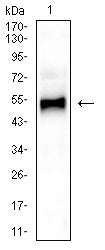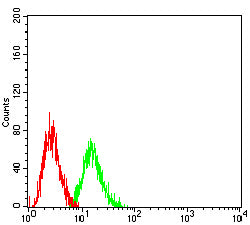




| WB | 1/500 - 1/2000 | Human,Mouse,Rat |
| IF | 咨询技术 | Human,Mouse,Rat |
| IHC | 1/200-1/1000 | Human,Mouse,Rat |
| ICC | 技术咨询 | Human,Mouse,Rat |
| FCM | 1/200-1/400 | Human,Mouse,Rat |
| Elisa | 1/10000 | Human,Mouse,Rat |
| Aliases | HDR; HDRS |
| Entrez GeneID | 2625 |
| clone | 1A10A11 |
| WB Predicted band size | 48kDa |
| Host/Isotype | Mouse IgG1 |
| Antibody Type | Primary antibody |
| Storage | Store at 4°C short term. Aliquot and store at -20°C long term. Avoid freeze/thaw cycles. |
| Species Reactivity | Human |
| Immunogen | Purified recombinant fragment of human GATA3 (AA: (294-443)) expressed in E. Coli. |
| Formulation | Purified antibody in PBS with 0.05% sodium azide |
+ +
以下是关于GATA3抗体的3篇参考文献的简要信息:
1. **文献名称**:*GATA3: A Multispecific But Potentially Useful Marker in Surgical Pathology*
**作者**:Miettinen M et al.
**摘要**:该研究评估GATA3抗体在多种肿瘤中的表达,强调其对乳腺癌、尿路上皮癌及部分神经内分泌肿瘤的诊断价值,同时指出其在鳞状细胞癌中表达率较低。
2. **文献名称**:*Comparison of GATA3 Monoclonal Antibody Clones for Detection of Metastatic Breast Carcinoma*
**作者**:Sasaki E et al.
**摘要**:研究比较了不同GATA3抗体克隆(如L50-823和HG3-31)的敏感性与特异性,发现克隆L50-823在转移性乳腺癌组织中具有更高的敏感性。
3. **文献名称**:*GATA3 Expression in Primary Urothelial Carcinoma and Metastases*
**作者**:Gwin K et al.
**摘要**:分析GATA3在尿路上皮癌原发灶及转移灶中的表达,证实其作为尿路上皮分化标志物的可靠性,但提示在部分腺癌中可能出现交叉反应。
这些文献聚焦于GATA3抗体的诊断应用、抗体性能比较及特异性分析,为病理诊断提供参考依据。
GATA3 antibody is a widely used immunohistochemical (IHC) marker that detects the presence of GATA-binding protein 3 (GATA3), a transcription factor critical for cellular differentiation and tissue development. GATA3 belongs to the GATA family of zinc-finger transcription factors and plays a key role in regulating gene expression in various cell types, including T lymphocytes, mammary gland epithelium, renal tubules, and the nervous system. Its involvement in maintaining cellular identity and function makes it a valuable biomarker in both research and diagnostic pathology.
In cancer diagnostics, GATA3 expression is strongly associated with luminal subtypes of breast cancer, where it is co-expressed with estrogen receptor (ER) and progesterone receptor (PR). It serves as a sensitive marker for identifying primary and metastatic breast carcinomas, aiding in differential diagnosis, particularly in distinguishing breast tumors from other malignancies. Additionally, GATA3 is highly expressed in urothelial carcinomas, making it useful in confirming urinary tract origins in metastatic settings. However, its expression is not entirely specific; it can also be detected in benign tissues and other neoplasms, such as cutaneous basal cell carcinomas or parathyroid tumors.
Beyond diagnostics, GATA3 antibodies are employed in research to study mechanisms of tumorigenesis, epithelial-mesenchymal transition, and immune regulation. Its dual role as a tumor suppressor or oncogene, depending on context, underscores its complex biological significance. Clinically validated GATA3 IHC assays are essential tools for precision oncology, enabling subtype-specific therapeutic strategies and improving diagnostic accuracy in routine pathology workflows.
×